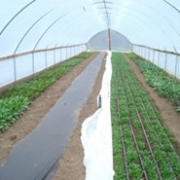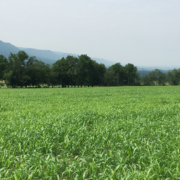High Tunnel Soil Management for Season Extension
 Print This Post
Print This Post
By Chris Lent, NCAT Agriculture Specialist
When I began to see how unique the growing conditions in my high tunnel are compared to open-field growing, I started to think differently about how to maintain soil health and manage soil fertility for high tunnel growing and season extension. Soil fertility is the soil’s capacity to hold essential nutrients and make them available to plants through a combination of chemical, physical, and biological conditions in the soil. The conditions created inside a high tunnel can affect soil health and fertility in unique ways. In this installment in my blog series on high tunnel season extension, I’ll talk about approaches to managing soil health and fertility.
When you step into a high tunnel, you’re moving off your farm in terms of temperature, humidity, and frost dates. Higher temperatures can speed crop growth and increase demands on the soil. Close plant spacings, quick crop successions, and extended seasons, typical in tunnel production, add to those demands. With increased crop successions comes increased soil preparation and tillage that can impact soil structure. At the same time, increased biological activity caused by warmer soils for more of the year can accelerate the breakdown of organic matter releasing nutrients and also deplete soil organic matter (SOM) levels. Salts from added compost, manure, or fertilizers can build up in the rain-free environment of a tunnel and accumulate near the soil surface, affecting crop growth. And because tunnel crops are entirely dependent on irrigation water, elevated alkalinity, iron, sodium, or chloride in the water can cause problems in the soil, as well.
There are several ways to overcome these soil health and fertility challenges, and autumn is a good time to start work on strategies for the extended season and to prepare for the following spring. These strategies start with soil testing. Testing around the same time each year will allow a fair comparison of any changes in the soil from test to test. In addition to a standard nutrient test that shows nutrient and pH levels, organic matter content and soluble salt levels should be tested. Based on the test results and crop requirements, you can begin to adjust pH levels in the soil and any nutrients that are deficient with the addition of lime or sulfur and rock powders and other amendments.

High tunnel kale crop for harvest through the fall. Photo: Chris Lent, NCAT
Soluble salt levels elevated enough to affect crop growth can be flushed with rainwater by leaving the plastic off the tunnel when installing new plastic or through irrigation. Twelve to 24 inches of water can flush 80% to 90% of the soluble salts from the soil. Irrigation water should be tested for excess salt and other nutrients and should be treated or filtered as needed. If compost is used as a soil amendment, using vegetation-based compost instead of composted animal manure can reduce the possibility of salt build-up in the soil.
High organic matter content is good for the soil and can benefit soil fertility… right? Yes, but SOM levels can be hard to maintain in a high tunnel. Many growers turn to compost to amend the soil and help raise SOM. Testing your source of compost for nutrient levels and soluble salt levels is a good idea to be sure it’s not contributing to problems in the soil. Cover crops, which I talk about below, are another good tool to increase SOM.
There has been much more research on the fertility needs of high-value, warm-season tunnel crops, like tomatoes, than on cool-season greens. But a few studies have indicated that increasing amounts of nitrogen fertilizer has little effect on yield in cool-season tunnel greens production. This is probably because most cool-season greens have a lower nitrogen requirement and there is enough left in the soil from what was supplied to summer crops. Secondly, we know that for each percent of organic matter above 2%, a nitrogen credit of about 20 pounds per acre can be considered before applying nitrogen fertilizer for a crop. For many fall and winter crops, this means no additional nitrogen is needed at all. Another good reason to be careful with nitrogen applications is that excess nitrogen in the soil has been linked to increased aphid populations in cool-weather greens production.

Planted at the start of September this fast-growing buckwheat was starting to flower by mid-October in the author’s high tunnel. Photo: Chris Lent, NCAT
Cover crops can help improve most soil-related issues in high tunnels. As I already said, they increase organic matter and improve soil structure, and leguminous covers can add nitrogen to the soil for the next crop without increasing salinity. Cover crops can also help break some pest and disease cycles. But it’s difficult for growers to sacrifice valuable high tunnel space for a non-cash crop. The timing of a cover crop and the type of cover used will vary by region, but the technique of under sowing a cover crop in warm-season tunnel crops like tomatoes or cucumbers can be a good strategy to prepare for fall and winter greens production. Another window to plant cover crops in a high tunnel is in the spring when winter greens harvest is slowing. Spring-planted covers won’t fully develop before summer crops should be planted but they can still contribute to soil health. Because of the numerous benefits to the soil that cover crops provide, some growers have opted to take a tunnel or a portion of one out of cash crop production for part of the season to plant cover crops.
More growers are trying reduced tillage techniques to protect the health and structure of their soil. Options here include shallow soil tillage (top 1 to 2 inches), no-till transplanting through a layer of compost or mulch, no-till transplanting through a winter-killed or crimp-killed cover crop, or the use of plastic tarps to control weeds and condition the soil before being removed to plant a crop. All these techniques are applicable to high tunnel growing and can be used to improve soil function by protecting the porosity and structure of the soil.
Growers who are using tunnels for main season and extended season growing are asking a lot of their soil. Regular soil and irrigation water testing, along with knowing nutrient levels in compost and other amendments, will help with balancing fertility to avoid issues. Cover crops used well can be very effective at improving and maintaining soil conditions. And reduced tillage techniques can also help overworked soils. With a combination of these approaches, high tunnel soils can be sustained for year-round crop production.
Related ATTRA Resources:
Season Extension Techniques for Market Gardeners
Sustainable Season Extension: Considerations for Design
Purchasing and Siting a High Tunnel to Extend the Growing Season
Organic Greenhouse Vegetable Production
This blog is produced by the National Center for Appropriate Technology through the ATTRA Sustainable Agriculture program, under a cooperative agreement with USDA Rural Development. ATTRA.NCAT.ORG.











